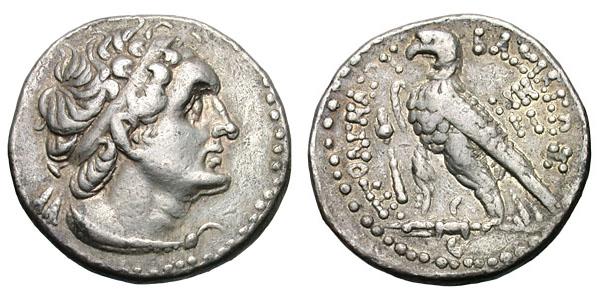S 620 - Citium (Ptolemy VI), silver, tetradrachms (170-163 BCE)
From SILVER
170 BCE - 163 BCE Silver 6,588 kg
Description
| ObverseInscription or printing placed on the obverse.: | Head of Ptolemy I Soter to right, wearing diadem and aegis around neck. |
| ReverseInscription or printing placed on the reverse.: | ΠΤΟΛΕΜΑΙΟΥ ΒΑΣΙΛΕΩΣ (Greek).Eagle standing to left on thunderbolt. In field, date (and Horus crown, cornucopia, owl, star, club, Isis crown). |
Mint and issuing power
| MintIdentifies the place of manufacture or issue of a numismatic object.: | Citium | Ancient regionAncient region.: | Cyprus | Modern countryModern country: Greece | AuthorityIdentifies the issuing power. The authority can be "pretended" when the name or the portrait of X is on the coin but he/she was not the issuing power. It can also be "uncertain" when there is no mention of X on the coin but he/she was the issuing power according to the historical sources: | Ptolemaic dynasty (323-30 BC), Ptolemy I Soter (satrap and Ptolemaic king of Egypt, 323-305 BC), Ptolemy VI Philometor (Ptolemaic king, 180-145 BC), Ptolemy VIII Physcon (169-164, 144-132/1 and 126-116 BC) |
Chronology
| FromIdentifies the initial date in a range assigned in a numismatic context. | 170 BCE | toIdentifies the final date in a range assigned in a numismatic context.. | 163 BCE | PeriodTime period of the numismatic object.: Hellenistic 323-30 BC |
Physical description
| MetalThe physical material (usually metal) from which an object is made.: | Silver |
Median weightMedian of the weights of numismatic objects (in grams). in grams | 14.10 | DenominationTerm indicating the value of a numismatic object. Examples: tetradrachm, chalkous, denarius.: | tetradrachm |
StandardStandard.: | Ptolemaic |
Image

S 620 - Citium Ptolemy VI Tetradrachm 170-163.jpg [1]
References
| Die study referencePublication of the study: | Olivier 20121Olivier 2012, p. 89-90, no. 1127-1139. | ||
| Coin series referenceReference to coin series study: | |||
Obverse dies distribution
| FrequencyFrequency of specimen in distribution. ᵖ | Number of obversesNumber of obverse dies. ᵖ (o) | % (o) | Number of coinsNumber of coins. (n) | % (n) | Die nameName(s) of the die(s). |
| 1 | 6 | 66.67 | 6 | 46.15 | 212, 213, 215, 218, 219, 220 |
| 2 | 2 | 22.22 | 4 | 30.77 | 214, 216 |
| 3 | 1 | 11.11 | 3 | 23.08 | 217 |
| Total | 9 of 9 | 100 | 13 of 13 | 100 |
Reverse dies distribution
no distribution is available
Quantification
| Number of obversesNumber of obverse dies. ᵖ (o) | 9 | Number of singletons (o1)The number of singleton coins. ᵖ | 6 |
| Number of reverse diesNumber of reverse dies. (r) | 8 | Number of coinsNumber of coins. (n) | 13 |
| Coins per obverse dieNumber of coins per obverse die. (n/o) | 1.44 | Coins per reverse dieNumber of coins per reverse die. (n/r) | 1.63 |
| Reverse per obverse ratioRatio of obverse dies divided by reverse dies. (r/o) | 0.89 | Percentage of singletons (o1)number of coins (n) divided by the number of singletons (o1) ᵖ | 66.67 % |
| Original number of dies (O) (Carter 1983 formula)The estimation of the number of coins according to Carter 1983 ᵖ | 23.36 | Coins struck if 20,000 as average productivity per dieCoins made if the average productivity for obverses (according to Carter) is 20,000. ᵖ | 467,200 |
| Original number of dies (O) (Esty 2011 formula)The estimation of the number of coins according to the singleton formula in Esty 2011 ᵖ (O) | 29.25 | Survival rate if 20,000 as average productivity per dieSurvival rate if average productivity is 20,000. ᵖ | 0.00003 |
| Coverage (o = % of O) (Esty 1984 formula)Esty 1984 - coverage (% of O) ᵖ (o = % of O) | 53.85% | Die productivity if survival rate 1/2,000Average productivity if survival rate is 1/2,000. ᵖ | 1,113.01 |
| Weight of silver (in kg) if 20,000 coins per die (O = Carter formula)Carter 1983 * Median weight * 20000 (*10 if gold or electrum) ᵖ | 6,588 kg <br /> 6,588 kg | Die productivity if survival rate 1/5,000Average productivity if survival rate is 1/5,000. ᵖ | 2,782.53 |
Remarks